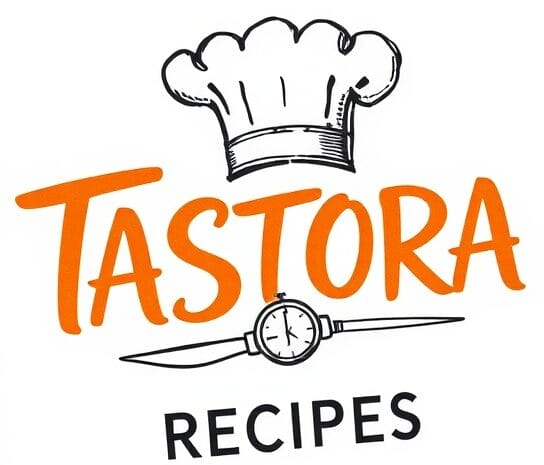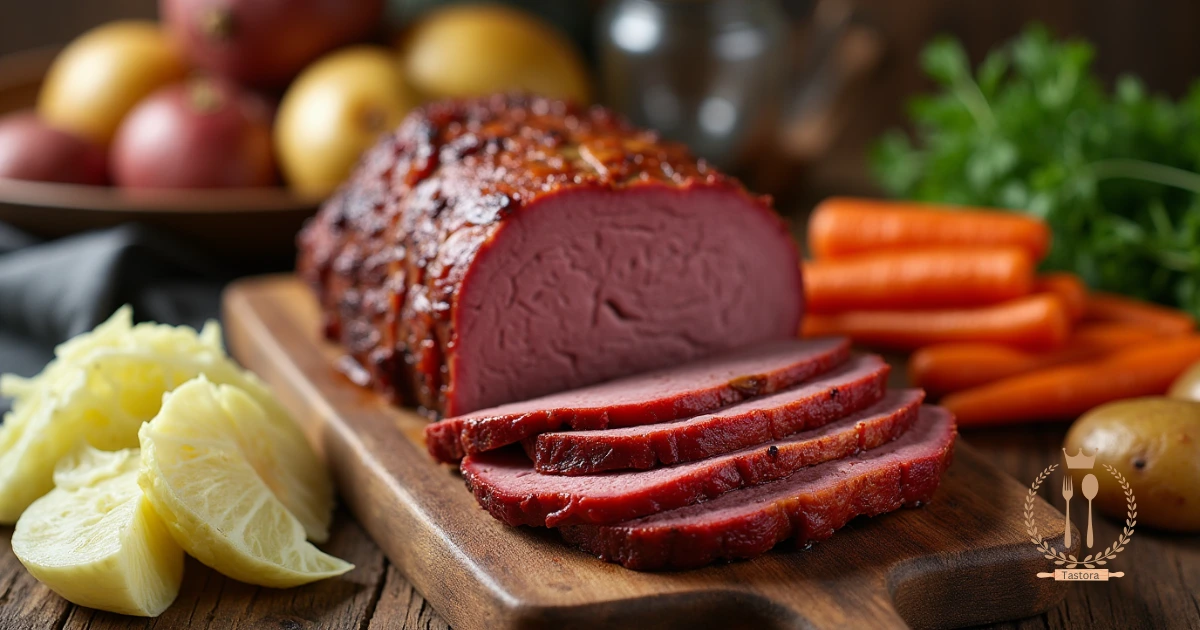Easy Baked Corned Beef and Cabbage Recipe for a Hearty Dinner
Forget boiling your corned beef this year! This oven-baked method transforms the traditional Irish-American favorite into something truly remarkable. By slow-roasting the corned beef instead of boiling it, you’ll create fork-tender meat with concentrated flavors and beautifully caramelized vegetables. The gentle heat of the oven allows the brisket to cook in its own juices, resulting in meat that’s more flavorful and succulent than the traditional boiled version. Whether you’re celebrating St. Patrick’s Day or simply craving a comforting Sunday dinner that feeds the whole family, this baked corned beef and cabbage recipe delivers restaurant-quality results with minimal effort. Get ready to discover your new favorite way to prepare this classic dish!
Ingredients for Oven-Baked Corned Beef and Cabbage
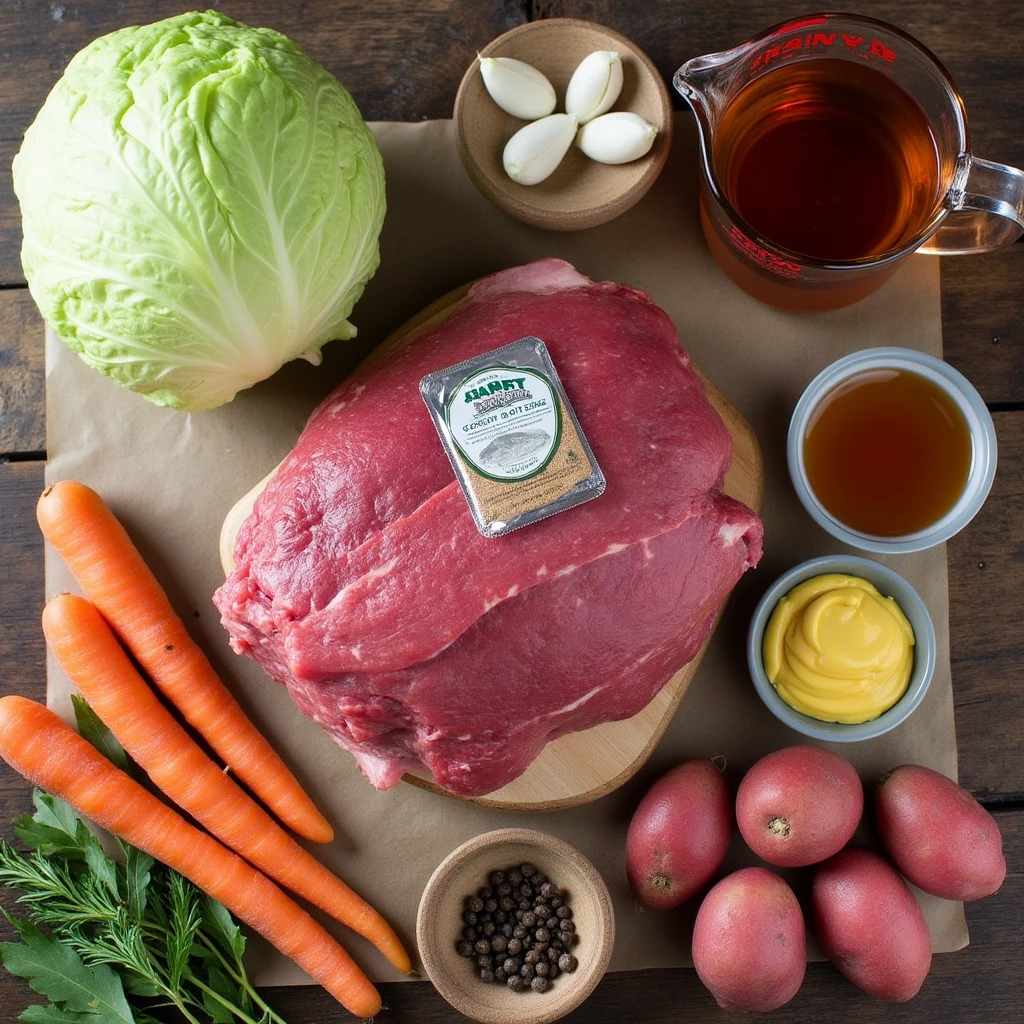
Corned Beef Brisket and Seasoning Packet
The star of the show is a 3-4 pound corned beef brisket, which typically comes packaged with its own seasoning packet. This seasoning blend usually contains mustard seeds, coriander, allspice, and other aromatic spices that give corned beef its distinctive flavor. When purchasing your brisket, look for one with a good fat cap, which will help keep the meat moist during the long baking process. The flat cut is leaner and slices beautifully, while the point cut has more marbling throughout for extra flavor. Either works wonderfully in this recipe, depending on your preference.
Green Cabbage and Root Vegetables
A medium head of green cabbage forms the traditional base of vegetables for this dish. When baked alongside the corned beef, cabbage wedges become tender while maintaining their structure, absorbing the savory juices from the meat. We’ll complement the cabbage with hearty root vegetables: 1½ pounds of baby potatoes (red or gold work best), 4 large carrots cut into chunks, and 2 large onions quartered. These vegetables not only provide substance to the meal but also develop a wonderful sweetness when roasted, balancing the savory flavors of the beef.
Beef Broth and Mustard for Moisture and Flavor
To create a moist cooking environment and infuse the meat with additional flavor, we’ll use 2 cups of low-sodium beef broth. This liquid provides the necessary moisture that would otherwise come from boiling, while adding depth of flavor rather than diluting it. We’ll also incorporate 2 tablespoons of whole grain mustard, which adds tanginess and complexity while complementing the natural spices in the corned beef. The mustard also helps create a beautiful glaze on the exterior of the meat as it bakes.
Spices Like Bay Leaves, Garlic, and Peppercorns
In addition to the seasoning packet that comes with your corned beef, we’ll enhance the flavor profile with 3 bay leaves for their subtle earthy notes, 4 cloves of garlic (either thinly sliced or minced) for aromatic depth, and 1 tablespoon of whole black peppercorns for a gentle heat that builds as the dish cooks. These additional spices create layers of flavor that make this baked version stand out from its boiled counterpart. Feel free to also add a tablespoon of brown sugar for a touch of sweetness that helps balance the saltiness of the corned beef.
How to Make Baked Corned Beef and Cabbage Step by Step
Preheat Oven and Prepare Your Roasting Pan
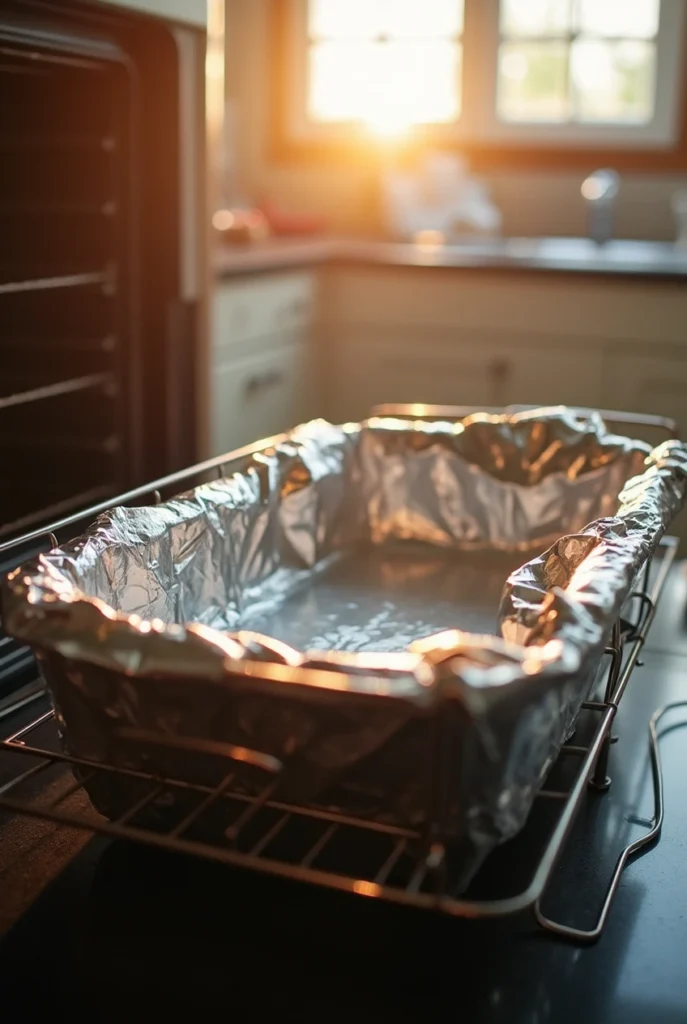
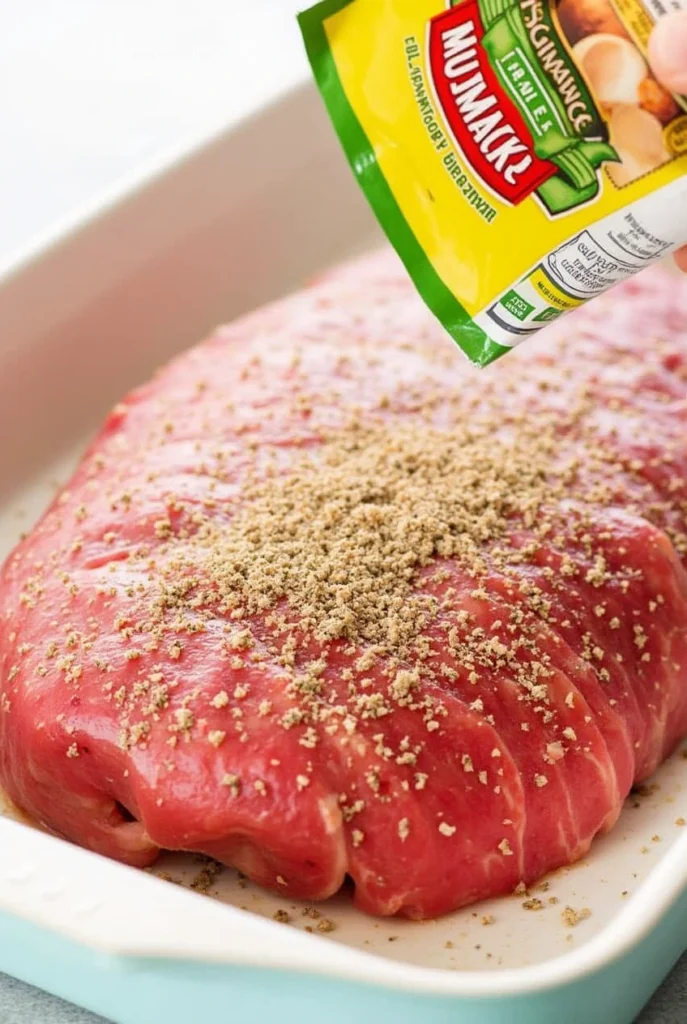
Begin by preheating your oven to 325°F (165°C), which provides the perfect temperature for slow, even cooking. Select a large roasting pan with enough room to eventually hold both the meat and all the vegetables. Line the bottom with aluminum foil for easier cleanup, and if you have one, place a roasting rack inside the pan. The rack elevates the corned beef, allowing hot air to circulate around it and ensuring even cooking. If you don’t have a roasting rack, don’t worry—you can create a makeshift one by arranging thick onion slices or celery stalks on the bottom of the pan to raise the meat slightly.
Season and Bake the Corned Beef First
Before placing your corned beef in the roasting pan, rinse it thoroughly under cold water to remove some of the excess salt from the brining process. Pat it dry with paper towels, then place it fat-side up on the rack. Sprinkle the contents of the seasoning packet over the meat, pressing gently to adhere. Mix the beef broth with whole grain mustard and pour it around (not over) the meat. The liquid will create steam in the oven, helping to keep the environment moist. Cover the roasting pan tightly with aluminum foil and place it in the preheated oven. Bake for approximately 2 hours before moving on to the next step.
Add Cabbage, Potatoes, and Carrots Later
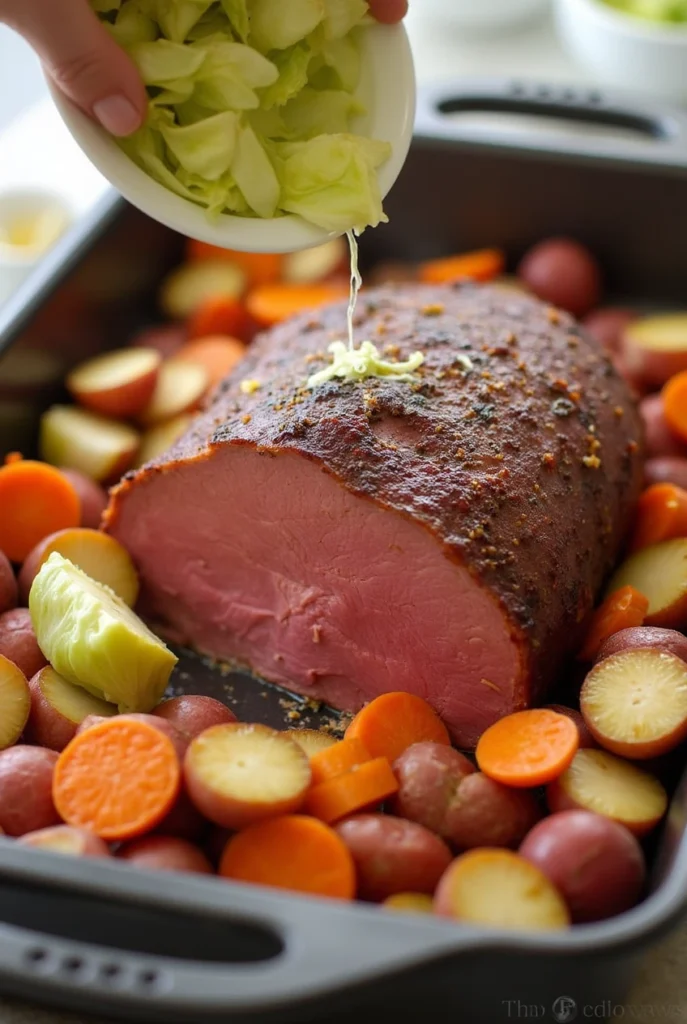
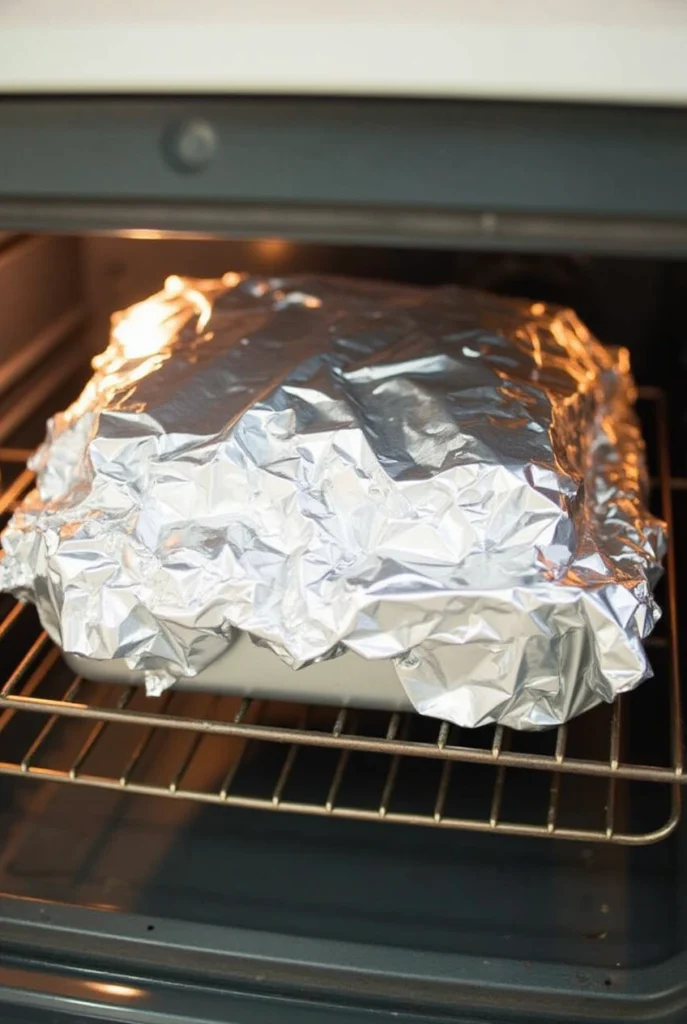
After the corned beef has been cooking for about 2 hours, carefully remove the pan from the oven and arrange the prepared vegetables around the meat. Cut the cabbage into wedges, leaving the core intact so they don’t fall apart during cooking. Arrange them alongside the quartered onions, carrot chunks, and baby potatoes. Sprinkle the vegetables with the remaining seasonings, including garlic, peppercorns, and bay leaves. Return the covered pan to the oven for an additional 1 to 1½ hours, or until the vegetables are fork-tender and the meat reaches an internal temperature of at least 145°F (63°C).
Cover and Bake Until Tender and Juicy
During the final hour of cooking, the magic truly happens as the flavors meld together. The vegetables absorb the aromatic spices and beef juices, while the meat continues to tenderize and develop a wonderful exterior. For the last 20 minutes of cooking, you can remove the foil to allow the top of the corned beef to brown slightly and develop a beautiful crust. This step is optional but adds great texture and visual appeal. The total cooking time will be approximately 3 to 3½ hours, depending on the size of your brisket. The meat is done when it’s fork-tender and easily pulls apart at the edges.
Why You’ll Love This Baked Corned Beef and Cabbage Recipe
Simple Ingredients with Big Flavor
One of the most appealing aspects of this recipe is how it transforms basic ingredients into a sophisticated meal. The simple combination of corned beef, cabbage, and root vegetables creates a dish that’s greater than the sum of its parts. By baking rather than boiling, each ingredient maintains its integrity while contributing to the overall flavor profile. The natural sugars in the vegetables caramelize slightly in the oven, adding complexity that you can’t achieve through boiling. And because everything cooks together, each component infuses the others with its unique characteristics, resulting in a cohesive dish with exceptional depth of flavor.
Perfect for Family Dinners or Celebrations
Whether you’re hosting a St. Patrick’s Day gathering or simply preparing a hearty Sunday dinner, this baked corned beef and cabbage recipe is guaranteed to impress. The generous portions make it perfect for feeding a crowd, and the hands-off cooking method means you can spend more time with your guests instead of hovering over the stove. Plus, the presentation is naturally beautiful—tender slices of pink corned beef surrounded by colorful vegetables makes for an eye-catching centerpiece that requires no elaborate garnishing or fussy plating.
Comfort Food That’s Easy to Prepare
Despite its impressive results, this recipe requires minimal hands-on time and basic cooking skills. Most of the cooking happens unattended in the oven, making it perfect for busy weeknights or lazy weekends. The preparation is straightforward: season the meat, arrange vegetables, and let the oven do the work. There’s no need for frequent stirring, flipping, or monitoring, which means less stress for you and more consistent results. This dish also reheats beautifully, so you can enjoy leftovers for days—if they last that long!
Great Alternative to Boiled Corned Beef
While boiling is the traditional method for preparing corned beef, baking offers several advantages. First, it prevents the meat from becoming waterlogged or losing flavor to the cooking liquid. Second, it allows for better control over the cooking temperature, reducing the risk of ending up with tough, stringy meat. Third, it creates a more concentrated flavor profile, as the natural juices recirculate rather than being diluted. Finally, baking produces a more interesting texture variation, with edges that can develop a slight crust while the interior remains moist and tender.
Expert Tips for the Best Corned Beef and Cabbage
How to Keep the Beef Moist and Tender
The key to perfectly moist corned beef lies in both the cooking method and the cut of meat. Always place the corned beef fat-side up in the roasting pan, allowing the fat to render slowly and baste the meat naturally as it cooks. The tight foil covering is crucial for creating a moist environment, trapping steam that helps break down the tough connective tissues in the brisket. For extra insurance against drying out, you can baste the meat with the pan juices every hour. If you notice the liquid level getting too low during cooking, add a little more beef broth or even a splash of dark beer for additional flavor and moisture.
When to Add the Vegetables for Even Cooking
Timing is everything when it comes to adding vegetables to your corned beef. Since cabbage, potatoes, and carrots cook much faster than the dense brisket, they should be added only during the last portion of cooking. Adding them too early would result in mushy, overcooked vegetables that lose their texture and visual appeal. The two-hour mark is generally ideal for a 3-4 pound brisket. For larger cuts, you might need to wait a bit longer. The vegetables should be cut into similar-sized pieces to ensure they cook evenly. If you prefer your cabbage with a bit more structure, you can add it a half-hour after the potatoes and carrots.
Resting the Meat Before Slicing
One step that should never be skipped is allowing the corned beef to rest after removing it from the oven. Place the meat on a cutting board, tent it loosely with foil, and let it rest for at least 15-20 minutes before slicing. This resting period allows the juices to redistribute throughout the meat rather than flowing out when cut, resulting in moister, more flavorful slices. While the meat rests, you can transfer the vegetables to a serving platter and keep them warm. When ready to slice, cut across the grain of the meat (perpendicular to the lines of muscle fiber) to ensure the most tender bites.
Serving Suggestions and Leftover Ideas
Serve your baked corned beef and cabbage with a side of good quality mustard or a creamy horseradish sauce for those who enjoy an extra kick. Traditional Irish soda bread makes an excellent accompaniment for soaking up the flavorful juices. For leftovers, consider making Reuben sandwiches with rye bread, Swiss cheese, sauerkraut, and Russian dressing. Alternatively, chop the meat and vegetables to create a delicious hash for breakfast, topped with fried eggs. The meat also freezes well for up to three months—slice it first and store with some of the cooking liquid to maintain moisture when reheated.
FAQs About Baked Corned Beef and Cabbage
Can I Make This Without a Roasting Rack?
Absolutely! While a roasting rack helps promote even cooking by allowing air to circulate around the meat, it’s not essential for this recipe. If you don’t have a rack, you can create a makeshift one using thick slices of onion or celery stalks arranged on the bottom of your roasting pan. This natural rack will elevate the meat slightly while adding extra flavor to the dish. Alternatively, you can place the corned beef directly on top of a bed of chopped root vegetables. The vegetables will partially cook in the meat juices, absorbing flavor while providing a buffer between the meat and the hot pan bottom, preventing any burning or sticking.
How Long Does Baked Corned Beef Take?
The total cooking time for baked corned beef depends primarily on the size of your brisket. As a general rule, plan for about 1 hour per pound when baking at 325°F (165°C). For a standard 3-4 pound corned beef brisket, the total cooking time will be approximately 3-4 hours. However, rather than relying solely on time, it’s better to check for doneness using a meat thermometer. The internal temperature should reach at least 145°F (63°C) for food safety, but for the most tender result, continue cooking until the meat reaches 190-195°F (88-91°C). At this higher temperature, the collagen in the brisket breaks down completely, resulting in meat that’s fork-tender and easily pulls apart.
Can I Bake Corned Beef Without Boiling It First?
Yes, and that’s precisely what makes this recipe so convenient! Unlike some traditional methods that require parboiling the corned beef to remove excess salt before the final cooking, this oven-baked version skips that step entirely. Instead, we rinse the corned beef thoroughly under cold water before baking, which removes enough of the surface salt while preserving the flavor that makes corned beef distinctive. The slow baking process allows the seasonings to penetrate the meat gradually, resulting in a perfectly balanced flavor without the extra work of boiling. This one-pot approach not only saves time but also preserves more of the meat’s natural flavor and nutrients.
What’s the Best Cut of Corned Beef to Use?
Corned beef typically comes in two cuts: the flat cut and the point cut. The flat cut (also called the first cut) is leaner, has a consistent thickness, and slices beautifully, making it ideal for presentation. The point cut (also called the second cut or deckle) has more fat marbled throughout, which results in a richer flavor and more tender meat, but it can be more difficult to slice neatly. For this baked recipe, either cut works well, though the flat cut might be easier for beginners since it cooks more evenly. If using the fattier point cut, you might want to trim some (but not all) of the fat cap to prevent the dish from becoming too greasy.
Conclusion
This oven-baked corned beef and cabbage recipe transforms a humble classic into a show-stopping dinner that’s perfect for any occasion. By swapping the traditional boiling method for gentle baking, you’ll create a meal with enhanced flavors, better textures, and an impressive presentation that requires surprisingly little effort. The slow roasting process allows the meat to become incredibly tender while the vegetables caramelize to sweet perfection—all in one pan for easy cleanup.
Whether you’re honoring Irish-American traditions or simply looking for a satisfying family dinner, this recipe delivers consistent results that will have everyone coming back for seconds. The detailed steps ensure success even for those cooking corned beef for the first time, while the expert tips help experienced cooks take their dish to the next level.
From its beautiful presentation to its rich, complex flavors, this baked corned beef and cabbage recipe deserves a regular spot in your meal rotation. So the next time you spot corned beef at your local market, grab it with confidence knowing you have a foolproof method that elevates this classic dish from ordinary to extraordinary. Your family and friends will definitely be impressed!
